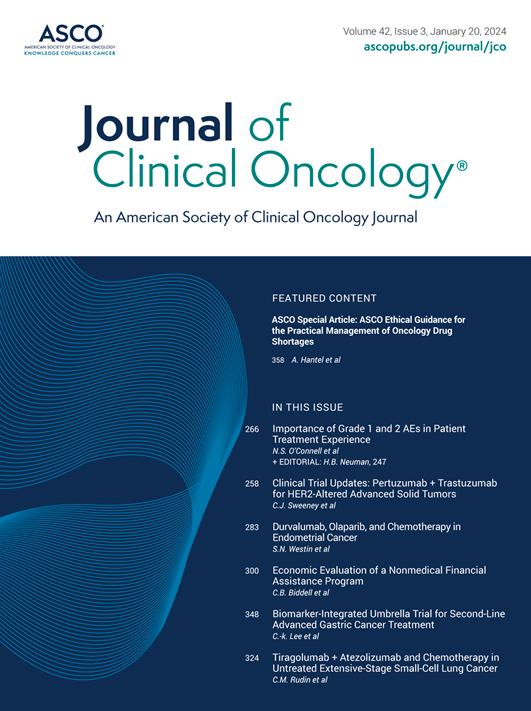Molecular characterization of NSCLC-like and SCLC-like subsets in Chinese pulmonary large cell neuroendocrine carcinoma (LCNEC).
IF 42.1
1区 医学
Q1 ONCOLOGY
引用次数: 0
Abstract
e13125 Background: LCNEC is an aggressive, biologically heterogenous carcinoma which can be molecularly characterized as SCLC-like and NSCLC-like. Accurate distinction of molecular subset is of major clinical relevance since it may guide treatment choices in LCNEC. Here we determined the genomic characteristics of the two LCNEC subsets in a Chinese cohort to clarify their correlations with traditional lung cancer histologies. Methods: FFPE samples from 31 LCNECs were sequenced using a 520-cancer-related gene panel, with an average sequencing depth of 1353X. Comparative mutational analysis was conducted between NSCLC-like LCNECs from our cohort and adenocarcinomas from TCGA dataset. Results: Despite similar clinical features in terms of stage and age at diagnosis, NSCLC-like (42%, 13/31) and SCLC-like (32%, 10/31) subsets from LCNEC displayed distinct molecular characteristics. NSCLC-like subset harbored significant higher mutation frequencies of STK11, KEAP1 and FAT3 (53.8%, 38.5% and 38.5%, p = .007, .046 and .046), while SCLC-like subset was characterized by highly mutated RB1 (100%, p < .001) and PTEN (50%, p = .007). Compared with TCGA adenocarcinomas, NSCLC-like LCNEC displayed more frequent mutations in TP53, STK11, APC, KMT2D and SMARCA4 (76.9%, 53.8%, 30.8%, 30.8% and 23.1%; p = .043, .004, .045, .005 and .049). In addition, potential targetable alterations were present in 46.2% (6/13) pts of NSCLC-like subset. For those advanced stage pts, 2/5 NSCLC-like and 5/5 SCLC-like pts received relevant chemotherapy according to their molecular characteristics. The clinical outcomes of these pts are still under follow-up. Conclusions: This study demonstrates the distinct molecular features between NSCLC-like and SCLC-like subsets, and highlights the predominant genomic similarity and separate entities between NSCLC-like LCNEC with adenocarcinoma. Given the evidence that genomic profiling may aid in informing treatment decisions for pts with LCNEC, our study indicates that, based on accurate molecular typing, 46.2% NSCLC-like pts may benefit from potential targeted therapy and the rest of them may be more suitable to receive NSCLC-chemotherapy.中国肺大细胞神经内分泌癌(LCNEC)中nsclc样和sclc样亚群的分子特征。
e13125背景:LCNEC是一种侵袭性、生物学异质性的癌症,其分子特征可为SCLC样和NSCLC样。分子亚群的准确区分具有重要的临床意义,因为它可以指导LCNEC的治疗选择。在这里,我们确定了中国队列中两个LCNEC亚群的基因组特征,以阐明它们与传统癌症组织学的相关性。方法:采用520-癌相关基因组对31个LCNECs的FFPE样本进行测序,平均测序深度为1353X。对我们队列中的NSCLC样LCNECs和TCGA数据集中的腺癌进行了比较突变分析。结果:尽管在诊断时的分期和年龄方面具有相似的临床特征,但来自LCNEC的NSCLC样(42%,13/31)和SCLC样(32%,10/31)亚群显示出不同的分子特征。NSCLC样亚群具有显著更高的STK11、KEAP1和FAT3突变频率(53.8%、38.5%和38.5%,p=0.007、.046和.046),而SCLC样亚群的特征是高度突变的RB1(100%,p<.001)和PTEN(50%,p=0.007)。与TCGA腺癌相比,NSCLC样LCNEC在TP53、STK11,KMT2D和SMARCA4(76.9%,53.8%,30.8%,30.8%and23.1%;p=0.043,.004,.045,.005和.049)。此外,46.2%(6/13)的NSCLC样亚型患者存在潜在的靶向性改变。对于晚期患者,2/5例NSCLC样和5/5例SCLC样患者根据其分子特征接受了相关化疗。这些患者的临床结果仍在随访中。结论:本研究证明了NSCLC样和SCLC样亚群之间的不同分子特征,并强调了NSCLC状LCNEC与腺癌之间的主要基因组相似性和独立实体。鉴于有证据表明,基因组图谱可能有助于为LCNEC患者的治疗决策提供信息,我们的研究表明,基于准确的分子分型,46.2%的NSCLC样患者可能受益于潜在的靶向治疗,其余患者可能更适合接受NSCLC化疗。
本文章由计算机程序翻译,如有差异,请以英文原文为准。
求助全文
约1分钟内获得全文
求助全文
来源期刊

Journal of Clinical Oncology
医学-肿瘤学
CiteScore
41.20
自引率
2.20%
发文量
8215
审稿时长
2 months
期刊介绍:
The Journal of Clinical Oncology serves its readers as the single most credible, authoritative resource for disseminating significant clinical oncology research. In print and in electronic format, JCO strives to publish the highest quality articles dedicated to clinical research. Original Reports remain the focus of JCO, but this scientific communication is enhanced by appropriately selected Editorials, Commentaries, Reviews, and other work that relate to the care of patients with cancer.
 求助内容:
求助内容: 应助结果提醒方式:
应助结果提醒方式:


